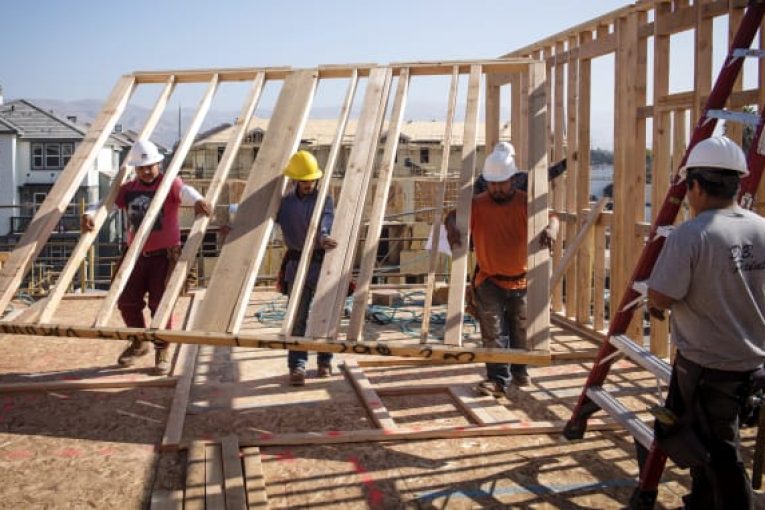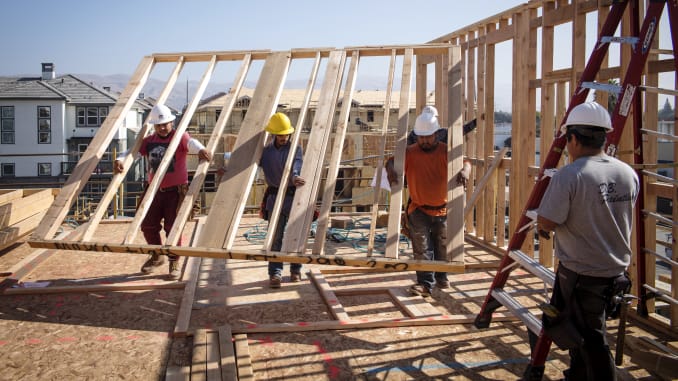

Last week Governor Gavin Newsom proudly sent out a press release boasting of signing 18 bills to boost housing production. One of those was not the controversial SB 50 sponsored by Senator Scott Wiener that would have done a number of things, including limiting low density housing near transit.
But the governor did sign AB 68, authored by Assemblymember Phil Ting, which allows for homeowners of single-family homes, who apply to build accessory dwelling units (ADUs) or “granny flats,” also to build a second “junior” ADU on their property.
It thus effectively rezones single-family homes into tri-plexes and acts as a de facto ban on single-family zoning.
“This law fundamentally shifts the landscape for building new homes in our state,” Brian Hanlon, co-founder and president of advocacy group California YIMBY said.
But this is not SB 50.
As the LA Times noted, “When California lawmakers tried earlier this year to force local governments to allow four or more homes on land zoned for single-family residences, fierce pushback from suburban communities stopped the plan in its tracks. For many, the long-standing neighborhood template of a home, backyard and garage on a lot was too intrinsic to the California lifestyle to upend.”
Instead the legislation this year, as it has over the past four years, “has quietly chipped away at zoning only for single-family homes, attracting comparably little blowback.”
Even with these more modest changes, it has created a huge difference.
“We’re on the precipice of single-family zoning functionally not existing,” said Ben Metcalf, former director of the state’s Department of Housing and Community Development, as reported by the Times.
The Sacramento Bee adds, “The farthest reaching new law will limit “downzoning,” or reducing the number of units that can be built in a particular space, such as only allowing a single-family home on a lot previously zoned for an apartment building.”
Governor Newsom’s response when signing AB 68: “We need to build more damn housing.”
There is also SB 330 which aims at “removing local barriers to housing construction and speeding up new development.”
The legislation, authored by Senator Nancy Skinner (Berkeley), “establishes the Housing Crisis Act of 2019, which will accelerate housing production in California by streamlining permitting and approval processes, ensuring no net loss in zoning capacity and limiting fees after projects are approved.”
“California’s failure to build enough housing has resulted in the highest rents and home ownership costs in the nation and has deepened homelessness,” said Senator. Nancy Skinner.
Then there is AB 1763, by David Chiu (of San Francisco – notice most of these bills are by Bay Area legislators) which attempts to create “affordable housing by giving 100 percent affordable housing developments an enhanced density bonus to encourage development.”
developments an enhanced density bonus to encourage development.”
“Since taking office in January, my Administration has been urgently focused on California’s housing affordability crisis,” said Governor Newsom. “The high cost of housing and rent is putting the squeeze on family budgets, and our housing shortage threatens our economic growth and long-term prosperity.
“In 2019, California has taken urgent action to address this challenge. We’ve invested more in new housing than at any point in our history, and we have created powerful new tools to incentivize housing production. Now, we are removing some key local barriers to housing production. This crisis has been more than a half century in the making, and this Administration is just getting started on solutions,” added Governor Newsom.
Housing affordability has been one of the key priorities of the new governor’s administration. The governor’s press release notes: “The state budget signed in June made a historic $1.75 billion investment in new housing and created major incentives – both sticks and carrots – to incentivize cities to approve new home construction.”
But all of this appears to be nibbling along the edges.
An August op-ed by the LA Times notes: “At a time when California desperately needs to be building a lot more housing to ease the statewide shortage that is driving up prices and fueling homelessness, the pace of residential construction is going down instead of up.”
Yesterday the Las Vegas Review Journal ran an editorial: “Texas shows how California can solve its housing problem.”
The editorial notes that Houston and Dallas have grown rapidly over the last decade, but, they “don’t face anywhere near the housing crunch that L.A. does. The median home price in Houston is $250,000. In Dallas, it’s $260,000. In L.A., it’s $618,000.”
To rent an apartment in Dallas and Houston it costs around $1300 per month compared to $2800 in LA.
They argue that “one piece of the puzzle is simple.” What is it? Building homes.
They write: “In contrast to L.A., Houston and Dallas allow builders to build homes. Last year, Houston issued 57,000 building permits for new housing units. In Dallas, that number was 62,000. Just 31,000 permits were issued in L.A. Combined, Houston and Dallas built 8.2 new housing units for every 1,000 people. In L.A., the ratio was 2.3 per 1,000.”
The editorial argues: “It may be difficult for the progressives running the People’s Republic of California to comprehend, but ignoring the basic concept of supply and demand has consequences.”
Of course you can argue that, while California may have too much in the way of restrictive zoning, Texas has too little. In many places, none. You end up with some strange neighborhoods as a result.
California also has important environmental protections in place, while Texas lacks them.
Overall I think that the editorial raises an important point – building does matter and allowing houses to be built is a clear necessary step toward solving the housing problem.
That said, I don’t think many people in California would support emulating Texas or, as the editorial puts it: “If California officials want to solve the state’s housing problems, they need to embark upon a quick fact-finding mission to Texas.”
What California does need to do is figure out better how to solve their housing problem. We have now had two cycles of legislation to solve this problem – and we have only nibbled around the edges. Wait too long and the legislators could find that the public loses patience and seeks a new direction.
—David M. Greenwald reporting







Words. No real actions. No concrete funding. Words.
Mission accomplished. Job well done. Get on to important things… who plays in MN Football tonight?
“It thus effectively rezones single-family homes into tri-plexes and acts as a de facto ban on single-family zoning”
No, it doesn’t.
Here, Rik, you are correct. You have correctly detected egregious hyperbole by the author.
That’s what the analysts are saying. I kind of agree with you – not much has changed.
Allows options, compels nothing…
David, 3 + minutes on “shot-clock” … no joy on edit… personal?
Hilarious that the DV is quoting a conservative paper pointing out the consequences of ignoring supply and demand — the same DV that regularly supports a skyrocketing minimum wage. What did I say would happen? Local, small-business restaurants would teeter and crash. Almost immediately, over a dozen restaurants & cafes I frequent started cutting hours. In the last several weeks, Bay Area newspapers have been publishing article after article about the string of local restaurant closures — what do they cite? High rents, the rising minimum wage and for some areas issues with vagrants. Who benefits? Large corporations with their chains. Thus, more sterilization of the landscape.
Hence, the exodus to places such as Texas. Failing to see a problem with that.
And – possibly stay there, along with all of the others who are leaving the state.
This is a response to “supply-and-demand” (or at least to the imbalance between wages and the cost of housing in California), but is somehow a concern of those who want California to emulate places like Texas. While citing the same “law” of supply-and-demand.
It doesn’t make a lot of sense, folks. There’s vast areas throughout the country, which provide a better wage/housing cost balance.
Hell, there’s even places within California that provide a better wage/housing cost balance. In fact, this is the reason that many residents initially migrated to places like Davis (from the Bay Area), years ago. It makes somewhat less sense, today – given that there are other areas which now provide a better balance. (Although the entire Sacramento region is still a primary destination for those looking to escape the situation in the Bay Area.) Prices in Sacramento and the region – including but not limited to Davis – have responded, accordingly. Although much of this is due to the rising cost of new construction.
Those concerned about rising rents would probably fare better to focus their efforts such as the following (rent control cap), which was also recently signed into law by the governor:
https://www.mercurynews.com/2019/10/08/governor-signs-california-wide-rent-cap-bill-into-law/
The truth of the matter is that not even one stick of new housing is needed to control rental prices, if robust rent control measures were in place.
Developers don’t build housing for the purpose of creating vacancies. They do so to accommodate and take advantage of additional renters.
The above . . . well, it reminds me of the greatest 30 seconds ever on video:
https://www.youtube.com/watch?v=JohGniYph-c
Despite being the target of the response, I find the video (above) highly amusing. Thanks for posting it.
If there are 100,000 homeless in California at $300,000 per unit you are going to need $30 billion. Newsom’s $1.75 billion is little more than a down payment on the problem.
DV… another suggestion for “don’ts” … links to cites/sites that require a charge to read them… insidious… you ‘buy’ access to the site … for a pittance… until you forget to cancel during the introductory period…
At least one of those on this thread…